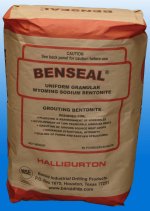SEALING & PLUGGING AGENT
 BENSEAL granular (8-mesh), natural Wyoming sodium bentonite is used in the sealing and grouting of well casings and earthen structures. BENSEAL is not recommended for use as a drilling mud.
BENSEAL granular (8-mesh), natural Wyoming sodium bentonite is used in the sealing and grouting of well casings and earthen structures. BENSEAL is not recommended for use as a drilling mud.
- High swelling capacity
- Uniform particle size
- No heat of hydration
- Prevents commingling of aquifers and contamination from surface
- Forms a flexible seal to protect casing from corrosive contaminants
- Allows for hole re-entry
- NSF/ANSI Standard 60 certified
APPLICATION
BENSEAL sealing and plugging agent assists or promotes the following:
- Seal or grout plastic or steel casings in monitor and water well construction
- Seal or plug abandoned boreholes
- Seal leaking ponds, ditches and dams
- Soil stabilization
- Prepare BENSEAL and EZ-MUD grouting system
- Aid in controlling loss of circulation
TYPICAL PROPERTIES
Appearance: Bluish to gray granules
Dry screen analysis: 85% as 8 mesh
Volume, ft³ /sack: 0.7 (as packaged)
Specific gravity: 2.6
MIXING & HANDLING
As a casing drill and drive operation:
- Dig a cone-shaped depression around casing. Depression should be 6 – 8 inches (152-203 mm) larger than the outside diameter of the casing and 2 – 3 feet (60-75 cm) deep.
- Keep cone-shaped depression filled with dry BENSEAL while driving the casing.
Note:
When drilling and driving a 4″ (102mm) pipe, expect to use 2.5 pounds of BENSEAL sealing and plugging agent per foot of hole or 3.7 kilograms per meter of hole.
Sealing ponds or earthen structures:
Depending on the native soil, disc in or mix 3 to 5 pounds of BENSEAL sealing and plugging agent per square foot (14-24 kg/m² ) uniformly over the area to be sealed so that a 6-inch (~152 mm) blanket of soil and BENSEAL sealing and plugging agent is formed. Do not neglect the edges of the dam or the sides/walls of the pond. This sealing blanket should then be compacted in place. As added protection to the sealing blanket, 2 to 4 inches (51-102 mm) of local soil or sand should cover the sealing blanket and be compacted. If the leaking area can be identified and isolated, an attempt can be made to broadcast BENSEAL uniformly at 4 to 6 pounds of BENSEAL per square foot (20-30 kg/m² ) of surface area into the water over the area of concern.
Note: Bentonite is more effective as a sealing agent when confined. Therefore, every effort should be made to cover the BENSEAL after it is broadcast with a 2-3 inch (51-76 mm) layer of sand. This will reduce the potential for dispersion into the water and un-yielded bentonite particles interfering with the gill action of fish.
Lost returns (moderate):
- Begin with the pit full of mud.
- Raise the pump suction off bottom and place a shovel next to it and slightly under suction.
- Pour dry BENSEAL slowly into the space between shovel and suction and pump it down the hole.
ADDITIONAL INFORMATION
The grouting material and method selected will depend upon the specific subsurface environment including all prevailing geological and hydrological factors and any existing regulatory requirements. The grouting process may not be complete until the grout is static at the desired level.
The use of bentonite may not be appropriate in environments where the formation water chemistry has a total hardness greater than 500 parts per million and/or a chloride content of greater than 1500 parts per million.
PACKAGING & CONTROLS
BENSEAL is packaged in 50-lb (22.7 kg) multiwall paper bags, containing 0.7 ft3 (0.02 m³).

